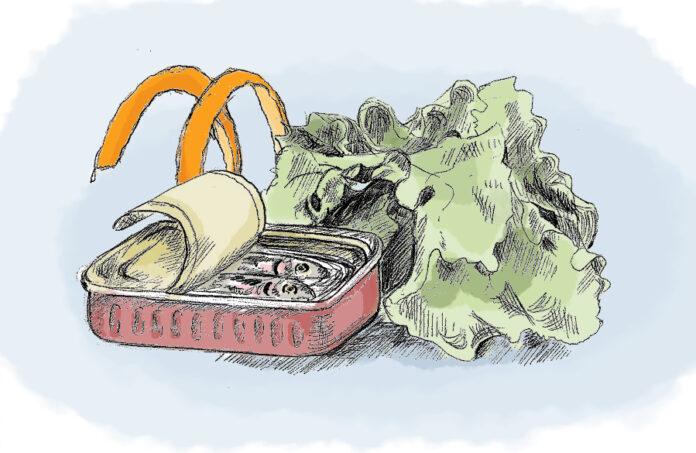Being a person who likes anchovies feels like being a part of a secret club. Looking down into a tin of salt-packed headless fish is a sight that generally doesn’t elicit excitement — but for those few for whom it does, it’s like staring into an untouched world. Only recently have the hip 20-somethings begun to catch on with their “tinned fish” in distinctly millennial packaging overtaking my Instagram feed. Restaurants like The Anchovy Bar have sprung up to great success and it feels like in the past few years, we’re all finally realizing what we’ve been missing.
Of course, not everyone feels this way, and I get it. I didn’t always like anchovies either. I mean, I always loved foods that included them, but the idea of ever eating one straight freaked me out. They smelled fishy and I’d stare at the spines in the sink catch when I washed my hands before dinner.
Over the years, I began to warm up to them. I would beg my mom for Caesar salad, and watch her clean the little fish from their spines before whirring them into a paste in our baby food processor to add to the dressing. Eventually, I was expected to help more in the kitchen. On nights where we had Caesar salad I’d cut and oil the bread for the croutons, grate the cheese and wash the lettuce — I could do everything but make the dressing.
And then one day my mom decided that I should learn to prep the fish — the only barrier that stood between me and my capacity to make the salad by myself. The round tins of Agostino Recca salt-packed anchovies were a staple in my house. We’d burn through a 28 oz tin a month. I never really looked at them, but my mom opened one and I looked at the little fish, tucked neatly in little lines beneath the grey salt.
My mom turned the faucet on to a cool gentle stream and told me to wash off the fish. I remember my surprise at the soft flesh under the rough granules of salt. Then, she ran the gentle water over the collar where the head was removed, and the filets peeled away from the spine. She pulled off the large fins and I asked her about the hair-like bones sticking up out of the filets. Was I expected to pull them all out?
“Don’t worry about those, they’re unnoticeable at the end.”
She tossed the filets into the bowl of the processor and watched me prep one myself, and then I was on my own.
I wasn’t sold on it. Preparing the fish was tedious at a time in my life when I took less joy from repetition and I was still squeamish about the occasional guts. I loved the nutty flavor that the little fish added to the salad dressings we so frequently made, but I had zero interest in eating the fish in their filet form. The smell was overly pungent and directly confronting those tiny bones freaked me out.
But over the years, they slowly crept onto my pizzas, into larger chunks in my salad dressings and onto little pieces of bread with cheese as I prepared the more substantial parts of meals. I’m unsure when exactly it happened, but I fell in love with anchovies. I’d think of them similarly to a very strong piece of cheese. I often eat them by themselves, savoring how sweet they are behind the salt, but my favorite way to eat them is to tear off a piece of bread, spread it with butter or mild cheese and place a few filets on top. Salad dressings are often improved by their addition, and when I have homemade pizza nights with my friends, I always include a few on my slices.
I’ve taken great inspiration from Estela’s, a New York City restaurant that serves an incredible anchovy and endive salad. I changed the ratios to allow a more serious, nutty anchovy flavor to ride parallel to the orange. You can make this in a food processor, but in my recipe testing, I simply pushed the filets through a garlic press which handily also removes 95 percent of the tiny bones and mixed it all with a fork.
Try your hardest to find salt-packed anchovies or splurge for a slightly nicer oil-packed brand. You can specifically look for one of my personal favorites, Agostino Recca (available at Eagle Rock Italian Bakery, or Cento (available at Safeway).
If you don’t have a zester for the orange, just finely chop the peel or use a cheese grater lightly over the surface, being sure to avoid the bitter white pith.
This is a versatile dressing — I’ve tossed endive in it and added some extra filets of anchovy and croutons, but I’ve also put it over some roasted baby broccoli and it was incredible. As winter comes, let citrus and sweet little fish carry your palate through to the summer.
Ingredients
Anchovy citrus dressing
8 filets of anchovy
2 garlic
1 Navel orange
2 tbsp olive oil
2 tsp white wine vinegar
Instructions
If using oil-packed filets, rinse well. If using salt-packed anchovies — remove spines and rinse gently.
Finely chop, or use a food processor or garlic press for the garlic and fillets.
Zest and juice one orange.
Mix ingredients together and taste. Salt if necessary.
Use as dressing or dipping sauce.
![]()



































